
Guanyin is a common Chinese name of the bodhisattva associated with compassion known as Avalokiteśvara. Guanyin is short for Guanshiyin, which means "[The One Who] Perceives the Sounds of the World". Due to sociogeographical factors, Guanyin can be historically depicted as genderless or adorning an androgynous apprentice. On the 19th day of the sixth lunar month, Guanyin's attainment of Buddhahood is celebrated. Guanyin has been appropriated by other religions, including Taoism and Chinese folk religion.
Religion in Singapore is characterised by a wide variety of religious beliefs and practices due to its diverse ethnic mix of people originating from various parts of the world. A secular state, Singapore is commonly termed as a "melting pot" or "cultural mosaic " of various religious practices originating from different religions and religious denominations around the world. Most major religious denominations are present in the country, with the Singapore-based Inter-Religious Organisation recognising 10 major religions. A 2014 analysis by the Pew Research Center found Singapore to be the world's most religiously diverse nation.
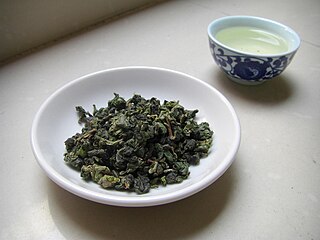
Tieguanyin is a variety of Chinese oolong tea that originated in the 19th century in Anxi in Fujian province. Tieguanyin produced in different areas of Anxi have different gastronomic characteristics.
Taoism in Singapore is the religion of about 8.8% of the country's entire population as per the 2020 census. The definition of "Taoism" in the country is included as part of the wider Chinese folk religion. In general, nearly all adherents of Taoism in Singapore are associated with the mainstream Zhengyi school. Larger proportion of older residents adhere to Taoism, as compared with those in younger age groups.
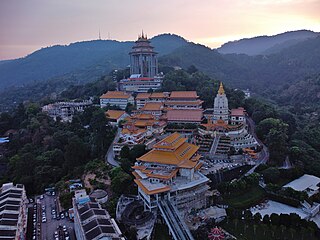
The Kek Lok Si Temple is a Buddhist temple within the city of George Town in the Malaysian state of Penang. Located at Ayer Itam, it is the largest Buddhist temple in Malaysia and an important pilgrimage centre for Buddhists from Hong Kong, the Philippines, Singapore and other parts of Southeast Asia. The entire complex of temples was built over a period from 1890 to 1930, an inspirational initiative of Beow Lean, the abbot. The main feature of the complex is the seven-story Ten Thousand Buddhas Pagoda commissioned by the late Thai king Rama VI, featuring 10,000 alabaster and bronze statues of Buddha and the 36.57-metre-tall (120 ft) bronze statue of Guanyin, the Goddess of Mercy. The 10,000 Buddhas concept belongs to the Chinese Mahāyāna school of Buddhism while Rama VI was king over a Theravāda country and Buddhist tradition.

Thian Hock Keng, is a temple built for the worship of Mazu, a Chinese sea goddess, located in Singapore. It is the oldest and most important temple of the Hokkien (Hoklo) people in the country. Another shrine at the back is Buddhist dedicated to Guanyin, the Mahayana Buddhist bodhisattva of mercy.

Waterloo Street is a two-way street in downtown Singapore stretching from Rochor Road to Bras Basah Road. It passes through the planning areas of Rochor and Museum Planning Area.

The Goddess of Mercy Temple, also known as Kuan Im Teng or Kong Hock Keong, is a Mahayana Buddhist temple within George Town in the Malaysian state of Penang. Located at Pitt Street, it was built in 1728, making it the oldest Buddhist temple in the state.
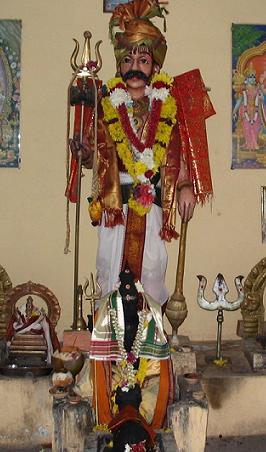
Muneeswarar, or Muneeswaran, is a popular Hindu deity within Hinduism, and is worshipped by many, in countries such as India, Malaysia, Singapore, Indonesia, Fiji and many more. He is sometimes referred to by different names, such as Muniyandi, Muniyappan, Muni Ayya, Ayya amongst many others. Muneeswarar is mostly considered a guardian deity or minor, but is in some cases hierarchically considered to be on par with Lord Shiva, one of the main deities in the Hindu trinity. Although not much is known on the exact origins and history of Muneeswarar, he is often regarded to be related to the Hindu Lord Shiva. His name is a combination of "Muni", and "Ishvara", an epithet or title of Shiva.

Jìngxiāng, shàngxiāng, bàishén, is a ritual of offering incense accompanied by tea and or fruits in Chinese traditional religion. In ancestral religious worship it's jìngzǔ or bàizǔ 拜祖. It is observed by a devotee holding joss incense with both hands in front of an altar during the worship. For greater reverence or devotion, the devotee will kneel and bow before the altar during and after placing the incense inside the urn at the altar.

Sri Krishnan Temple is a Hindu temple in Singapore. Built in 1870 and gazetted as a national monument of Singapore in 2014, it is one of Singapore's oldest temples and is the only South Indian temple in Singapore dedicated to Krishna and his consort Rukmini. The Sri Krishnan Temple and the nearby Kwan Im Thong Hood Cho Temple are known for having evolved a social practice termed "cross-worshipping", where many devotees of either temple also worship at the other. This practice is commonly seen as a microcosm of Singapore's multi-religious society.
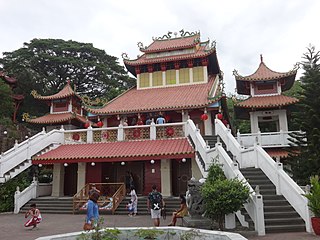
The Ma-Cho, Mazu or Ma Cho Temple is a Taoist temple to the Chinese Sea-Goddess Mazu located on Quezon Avenue in Barangay II, San Fernando, La Union in the Philippines. It was built in 1977 by a group of Filipino-Chinese devotees under the leadership of Dy Keh Hio and with the support of former Tourism Secretary Jose D. Aspiras.

Chinese folk religion plays a dynamic role in the lives of the overseas Chinese who have settled in the countries of this geographic region, particularly Burmese Chinese, Singaporean Chinese, Malaysian Chinese, Thai Chinese, Indonesian Chinese and Hoa. Some Chinese Filipinos also still practice some Chinese traditional religions, besides Christianity of either Roman Catholicism or Protestantism, with which some have also varyingly syncretized traditional Chinese religious practices. Chinese folk religion, the ethnic religion of Han Chinese, "Shenism" was especially coined referring to its Southeast Asian expression; another Southeast Asian name for the religion is the Sanskrit expression Satya Dharma.

Kian Un Keng Shrine or spelled Kuan An Keng Shrine, known internationally as Guanyin Shrine (ศาลเจ้าแม่กวนอิม), is an ancient Chinese joss house in Bangkok, located on the western bank of Chao Phraya River, Wat Kanlaya Subdistrict, Thon Buri District, Thonburi side in the area of Kudi Chin community close to other places of worship including Wat Prayurawongsawat, Wat Kalayanamitr and Santa Cruz Church with Bang Luang Mosque.

Sculpture Square was a non-profit arts organization located at 155 and 161 Middle Road, Singapore. It was founded by sculptor Sun Yu-Li in 1995 as a venue with the focus on exhibiting and fostering ‘3-dimensional’ and other forms of sculptural arts in Singapore.
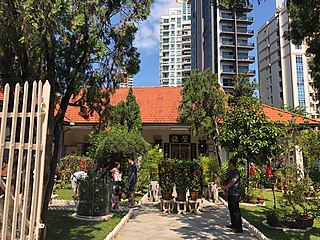
Chan Chor Min Tong is a Buddhist vegetarian hall located in Balestier, Singapore. It is separated into two locations, one at 2 Jalan Kemaman and another at 3 Bassein Road. Built by the Cantonese philanthropist Chan Chor Min in 1926 and 1936 respectively, the hall hosted migrant Chinese workers with no family or means of support in Singapore. From being a place of lodging to now being a place of worship, Chan Chor Min Tong is significant as a representation of the vegetarian hall culture as well as the migrant origins of Singapore.

Cundhi Gong Temple is a temple on Keong Saik Road in Chinatown, Singapore. Completed in 1928, it was initially a branch of a now-demolished temple on Upper Chin Chew Street.



















